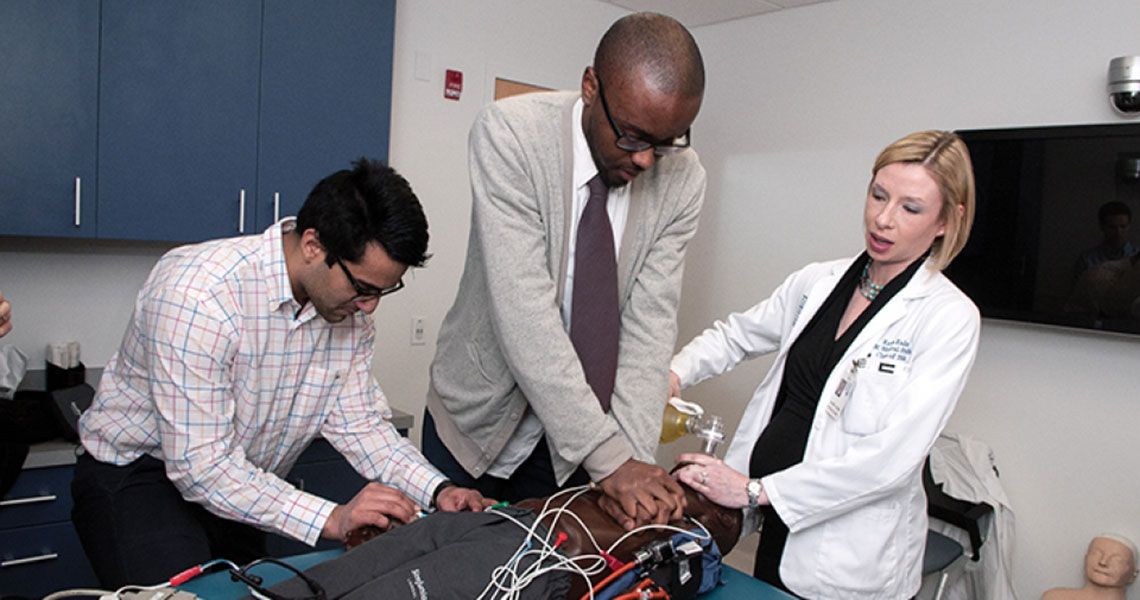It wasn’t long ago that medical students relied on the nearly 1,000-page “Bates’ Guide to Physical Examination and History Taking” to learn crucial examining skills.
“We were instructed that if you put your stethoscope in the right spot and heard crackles in the left lower lobe, it was pneumonia,” said Claudia Ranniger, assistant professor of emergency medicine at GW’s School of Medicine and Health Sciences (SMHS). “As students, our response was often, ‘OK, if you say so.’ ‘See one, do one, teach one’ was the aphorism of the day.”
Much has progressed since those days of hands-off medical training. Now, simulation has swept the medical education world, and GW is providing one of the most innovative educational environments for budding healthcare professionals.
Dr. Ranniger is co-medical director of SMHS’s new Clinical Learning and Simulation Skills (CLASS) Center, a facility that is changing the way GW students learn medicine. The new 17,000-square-foot center opened its doors on the fourth floor of Walter G. Ross Hall this spring, replacing a much smaller space on the 6th floor of the GW Hospital that had been used for simulation since 2002. The CLASS Center enables realistic scenarios for real-time training, with features like virtual reality and mock operating rooms to offer hands-on practice.
While it was designed primarily to educate medical students, its technology makes it an ideal setting to teach students from many different disciplines.
The CLASS Center incorporates two modes of simulation: standardized patients—carefully trained professionals who play the part of patients suffering from any number of medical maladies—and mechanical simulators that can mimic physiological conditions. A common reception area joins the human and technological spaces together.
Standardized patients provide feedback and help students develop their communication skills, while the mechanical simulators allow students to learn how to use ultrasound, practice deliveries and perform procedural skills. Rather than taking a professor’s word for it, GW students can now rely on simulation stethoscopes that wirelessly transmit any sound to a stethoscope receiver.
The use of advanced medical simulators, including full-body computerized manikins and haptic surgical trainers, is built into each stage of SMHS’ clinical skills training. Students can learn the basics of a procedure such as IV placement or resuscitation of a critically ill patient using simple anatomic models.
“Students get feedback from a variety of sources,” said Karen Lewis, adjunct assistant professor of medicine and administrative director of the CLASS Center. “Not only from the faculty, but also from the standardized patients, from their classmates who are watching the encounters, and even by watching themselves on film.”
Together, the standardized patients and the simulators allow SMHS to “train students in the performance of clinical skills, procedures, teamwork and communication, which we can’t easily do in a patient environment,” said Dr. Ranniger. The center complements SMHS’ clinical skills curriculum by giving students what Dr. Ranniger calls, “a safe place to learn and practice skills without the fear that something bad will happen.”
Jeffrey S. Akman, dean of the School of Medicine and Health Sciences and vice president for health affairs, tours the new CLASS Center with George Washington President Steven Knapp.
In addition to 12 outpatient and two inpatient examination rooms for standardized patient encounters, the CLASS Center boasts a labor and delivery suite, a mock operating theater, two high-fidelity rooms and laboratory space for procedural skills training. Smart Board-equipped conference and debriefing rooms enhance opportunities for performance review—a crucial component of the hands-on training space.
The 99 well-concealed cameras dispersed throughout the center—many of which are mounted low to record facial expression and body position—allow faculty to play back individual and team patient care exercises for students, highlighting the strengths and weaknesses of the performances.
“We’re not just interested in patient care in the exam room,” Dr. Ranniger said. “The cameras also allow us to monitor what happens during patient transport. How many wires do we run over? How many things do we drop? All of these are important to improve teamwork, which in turn helps us improve care.”
A sophisticated data system allows for curricular content to be pushed from a control room to any of the 32 screens mounted throughout the CLASS Center. X-ray images, footage of real patients and technique demonstration are just a few types of content that can be displayed to students working in the center.
The expanded size of the CLASS Center encourages more complex and authentic patient encounters.. Standardized patients and task trainers can be employed in single, mixed-modality simulations, improving results in the clinical environment.
In one such exercise, students must insert an IV into an arm simulation, while a standardized patient appears to be very anxious about the procedure.
These types of hybrid exercises, which incorporate interprofessional teams such as medical, physical therapy, and physician assistant students “are some of the many exciting future directions for the new state-of-the-art CLASS center,” said Benjamin (Jim) Blatt, professor of medicine and co-medical director of the CLASS Center. “Medical practitioners trained at SMHS will graduate having achieved high levels of competency through realistic scenarios created with human and mechanical simulation.”
A version of this story originally appeared in Medicine + Health, a biannual publication of the School of Medicine and Health Sciences.



